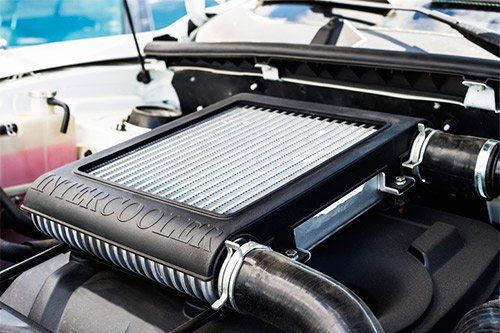4 Facts About Charge-Air Coolers for Forced Induction Engines
- By Admin
- •
- 19 Jun, 2019

If you drive a vehicle with a forced-induction (turbocharged or supercharged) engine, your vehicle may have a charge-air cooler mounted somewhere between the turbocharger and the motor. If your forced-induction vehicle doesn't have a charge-air cooler, it probably needs one. Here are four facts about charge-air coolers.
1. Charge-Air Coolers Go by Several Names
Your radiator and cooler professional may call your charge-air cooler by one of several names. The term "charge air" is a blanket term to indicate one of several specific types of automotive heat exchangers.
Alternate names for charge-air coolers include the following:
- Aftercooler
- Intercooler
- Turbocooler
Intercooler is a common term used for the devices, since the coolers normally work in between stages of compression. Aftercooler and turbocooler are terms that refer to the coolers' treatment of compressed air (known as the charge air) after the hot compressed air leaves the turbocharger.
Designs for charge-air coolers vary depending on whether the device is an air-to-air or air-to-liquid cooler. Charge-coolers also carry various pressure ratings to match the pressures of intake air they treat.
2. Intercoolers Are Heat Exchangers
Charge-air coolers lower the temperature of air between a turbocharger and the engine. The coolers act as heat exchangers to remove waste heat from turbocharged air. The cooled, turbocharged air enters an automotive engine at a lower, safer temperature than turbocharged air that isn't cooled.
The charge-air cooler enhances engine performance by increasing the density of intake air. Un-cooled intake-manifold flow at the same high density could exceed the heat tolerances for an engine and lead to early engine failure.
Charge-air coolers perform the following tasks:
- Promote more complete combustion
- Eliminate danger of pre-detonation (engine knocks)
- Increase torque output of engines
Some air-to-air and air-to liquid charge-air coolers cause a slight weakening of boost pressure, but the benefits to the engine's performance and longevity more than make up for the slight lag.
3. Charge-Air Coolers Mount in Several Locations
Factory and aftermarket air-to-air or air-to-liquid charge-air coolers can be mounted in several spots on a vehicle. The ideal placement for a retrofit charge-cooler on your ride depends on the make and model of the vehicle you drive and the type of cooler being installed.
Air-to-air coolers come in front-mounted, side-mounted, and top-mounted designs, which each have their drawbacks. Front-mounted coolers are sometimes more efficient than side-mounted coolers but are prone to collect road debris. Top-mounted coolers can overheat from proximity to the engine and deliver less than ideal cooling to intake air.
Air-to-liquid charge-coolers add weight to a vehicle and require space to install. Air-to-liquid coolers require a water pump, pipes, and sometimes their own radiator setup.
4. Charge-Air Coolers Protect High-Performance Engines
Excess heat and incomplete combustion cause wear and tear on engine components. Charge-air coolers protect an engine by reducing high intake-air temperatures and enhancing fuel combustion.
The engine is better off with charge-air coolers, since they prevent the following issues:
- Weakened hot spots in engine
- Warped or cracked piston crowns
- Warped or cracked exhaust valves
- Damaging pressure spikes in cylinders
However, your charge-air cooler must be maintained like any other vital automotive component. If you experience performance issues with your supercharged or turbocharged vehicle, schedule an inspection of your engine cooling system first.
Components of a charge-air system can corrode, get gummed up with junk, or break. Engine mounts jiggle loose, filters need to be changed, and water-cooled devices need flushing. After your radiator and automotive cooler professional services your charge-air cooler, you may discover that a little bit of intercooler maintenance was all you needed to hear your engine purr.
If your high-performance car or diesel truck in Douglasville, Georgia, is running sluggishly or getting too hot too soon, have the vehicle checked out by Kell Radiator Service. We service automotive cooling systems for customers throughout the Greater West Atlanta region.

